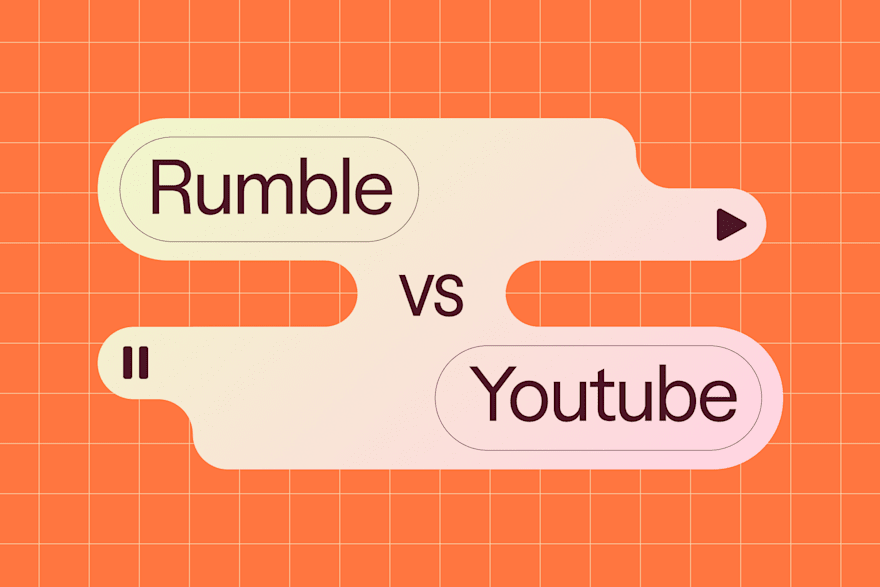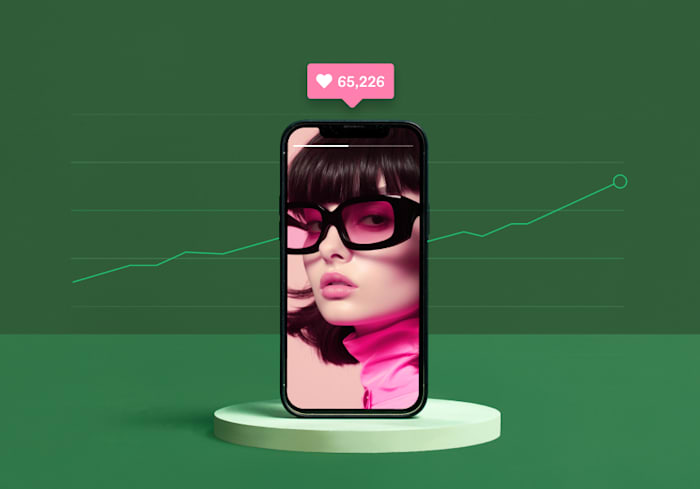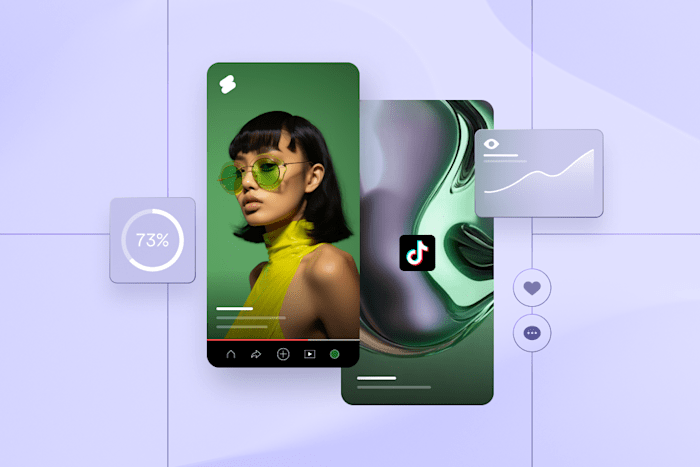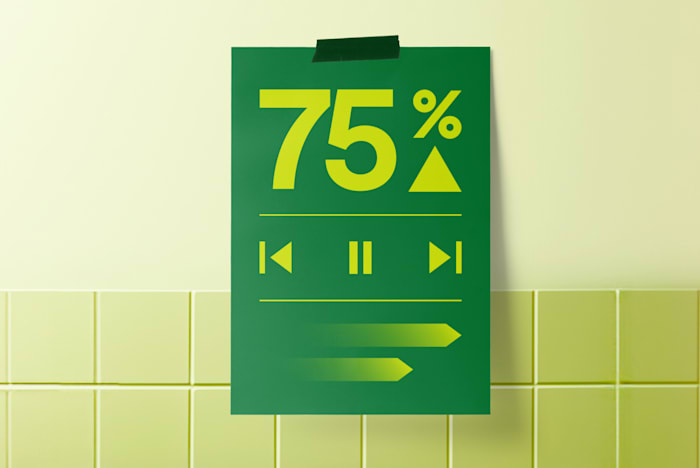Rumble vs. YouTube: Comparison Guide
Choosing between Rumble and YouTube? This guide breaks down what creators need to know.
 April 28, 2025
April 28, 2025 9 minute reading
9 minute reading
When someone says they're a video content creator, one of the top questions people will ask them is, "What's your YouTube channel called?" Such is the popularity of YouTube for creators and users.
Despite YouTube’s popularity, there are other platforms for video creators that you might want to weigh up—either as a complete alternative or to complement your YouTuber career. One option is Rumble.
We'll cover the 1:1 differences between YouTube and Rumble, including:
By the end of the guide, you'll have a better understanding of which platform suits you as a creator or for diversifying your business's video content strategy.
What is YouTube?
YouTube is a video-sharing and social media platform for watching and uploading videos. Google acquired it in 2006 for under $2 billion, after it was launched in 2005.
Today, it is the most popular online video property in the U.S., generating over $36 billion in advertising revenues in 2024.
What is Rumble?
Rumble.com is also a video sharing platform, founded in 2013 by Chris Pavlovski as an alternative to YouTube for independent vlogs and beginners in content creation.
You may not have heard of it, but users uploaded an average of 12.5k and 15.5k hours of video to the platform daily between 2023 and 2024, generating around 8.5 billion minutes of watch time per month. In Q2 2024, Rumble generated $22.47 million in revenue.
Rumble vs. YouTube
Rumble is a smaller platform, but that doesn't mean it's not worth exploring. So, let's drill into the differences between Rumble and YouTube.
Platform overview
Let's gather more details on each platform's history, market positioning, and user demographics.
Rumble’s overview
As mentioned above, Pavlovski launched Rumble in 2013 to offer a YouTube alternative for smaller creators (instead of mega-influencers). Here’s a quick timeline:
Launched in 2013.
Hit one million monthly video views in 2014.
Rumble player earned the fastest player rating on Google Developer Insights.
ComScore ranked Rumble as one of the top 50 video sites, and content creators earned over $4 million from it.
Rumble ranked on roundup lists from 2016 to 2021.
Narya and Peter Thiel Lead Investment in Rumble in 2021.
Viewer engagement grew 44x in Q3 2021.
Since 2021, the Rumble platform has become more popular among Conservative creators frustrated with YouTube's content policies. The Founder/CEO of Rumble says, "Rumble is designed to be the rails and independent infrastructure that is immune to cancel culture." This suggests users value its approach to “free speech.”
Rumble last reported 53 million monthly active users in 2024. Rumble’s audience is mostly made up of 25–34-year-old (21.01%) male users (66.04%) in the United States (66.39%).

SimilarWeb
YouTube’s overview
After Google acquired YouTube, it became a cultural phenomenon—especially in the music industry. This is evident considering every video in YouTube's top-ten most watched videos (as of February 2025) are all music videos.
Hire a YouTube expert on Fiverr
Here are key moments in YouTube's history:
Launched in 2005.
Acquired by Google in 2006.
YouTube's Partner Program launched in 2007 along with in-video ads.
Hit the first 1-billion-view video in 2013.
Introduction of YouTube Red in 2015.
YouTube Red rebranded as YouTube Premium in 2018.
YouTube hit 2 billion users in 2019.
Second most popular social network in 2022.
YouTube Premium reached 26.7 million users in 2023.
YouTube has about 2.5 billion users in 2025.
Compared to Rumble, YouTube's audience of creators and viewers are significantly more diverse, precisely because of how massive its user base is. Even still, YouTube's largest demographic is also 25–35-year-old male users (12%):

Datareportal
Content policies
With the overview done, we'll cover specific aspects of the platforms—starting with the content policies.
Rumble’s policies
Though people perceive Rumble as a more "relaxed" platform in terms of content moderation, it still has obvious and reasonable content restrictions:
Content or material copyrighted by third parties (or isn't yours), including trademarks.
Pornographic, obscene, or adult content.
Material grossly offensive to the community, including (but not limited to) racism, anti-Semitism, and hatred.
Content that promotes, supports, or incites violence or unlawful behavior.
Content that encroaches on others’ rights, including privacy, publicity, and reputation.
Interestingly, content or material that Rumble deems "undesirable" on the service.
In terms of detection and enforcement, it's less clear. Users can submit complaints to the platform moderation team via email. Otherwise, in Rumble's terms and user agreement, they say:
"You acknowledge that Rumble has the absolute right (but not the obligation) to prohibit, refuse, delete, move and edit Content and material for any reason, in any manner, at any time, without notice to you."
YouTube’s policies
YouTube has clearly defined content policies in the Community Guidelines, which has six categories of guidelines:
Spam and deceptive practices (though this covers activity more than content).
Sensitive content (including child safety, suicide, self-harm, and vulgar language).
Violent or dangerous content (including harassment/bullying, violent/graphic content, crime, hate speech).
Regulated goods (including firearms and the sale of illegal goods).
Misinformation.
EDSA (Educational, documentary, scientific, and artistic) content (which covers when otherwise restricted content may stay on YouTube).
In terms of detection, YouTube uses a user-reported flagging system and a people and machine learning system to remove content at scale.
For enforcement, YouTube uses a "three-strike" system that counts both content and copyright policies. Getting three strikes within a 90-day period usually results in channel removal.
Monetization models
Now, let's talk about monetization opportunities. Both platforms use an ad-based revenue model, and you can also seek content sponsorship deals on both, but there are a couple of other key differences.
Rumble’s monetization models
Ad revenue sharing is the basic monetization method through Rumble's Partner Program. However, there are other monetization methods on the platform, including:
Partnerships. The platform chooses content for syndication across partnered media companies.
YouTube revenue. Creators earn revenue through the Rumble YouTube channel. That is, if the platform shares your content on their YouTube channel, you get a cut of the ad revenue.
Video licensing. Creators earn money through content licensing. Rumble offers four licensing options:
Exclusive video management, giving Rumble full rights to your content.
Excluding YouTube video management, giving Rumble rights management while excluding YouTube content (meaning you can cross-post).
Rumble-only: Where you manage and monetize content on Rumble only (but you retain the rights).
Personal Use: for sharing content without monetization.
Video challenges. Creators can win money if their videos rank or win in platform-hosted challenges.
Another big consideration is that you don't need a specific number of followers to apply for the partner program. If your content performs well, you can earn ad revenue from day one on the platform.
Hire a Rumble expert on Fiverr
YouTube’s monetization models
YouTube's monetization options are more well-known and transparent in terms of payment structure.
All YouTube monetization features have minimum subscriber and performance thresholds, so you won't be able to monetize when you first create a YouTube channel.
If your channel has:
500 subscribers.
3 public uploads in the last 90 days.
Either:
3,000 public watch hours on long-form videos in the last 365 days.
3 million public Shorts views in the last 90 days.
You'll access these monetization features:
Channel memberships. User membership subscriptions for access to your exclusive content.
Super Thanks, Super Chat, and Super Stickers. Users can buy these to highlight their messages in live chats.
Shopping. This lets you promote your products if you have them (best for businesses on YouTube).
If your channel has:
1,000 subscribers.
Either:
4,000 public watch hours on long-form videos in the last 365 days.
10 million public Shorts views in the last 90 days.
You'll also have access to YouTube's ad revenue sharing from Watch Page ads, Shorts Feed ads, and YouTube Premium revenue.
YouTube pays creators 55% of the ad revenue share for Watch Page ads and 45% for Shorts Feed ads. For other commerce features (Shopping and Supers), YouTube pays 70% of net revenue.
Creator-friendly features
Both platforms have similar video uploading features, where you can customize the video title, description, categories, thumbnail design, and visibility. But there are a few differences in creator features.
Rumble’s features
Compared to YouTube, Rumble lacks features that allow creators to spice up their content. But it does have more in-depth live video streaming, called Rumble Studio, which is technically a sister app, rather than the platform itself.
In the Rumble Studio app, creators can stream live to Rumble, Locals, Facebook, YouTube, and Twitch with up to nine guests in the "Canvas."
Beyond standard livestreaming features (compared to similar livestreaming apps), Rumble also has a "Caller Queue" for live calls from your audience, and "Clips" to export favorite moments (coming soon).
YouTube’s features
Compared to Rumble, YouTube has more creative/social functionalities (besides live streaming), including:
Community Posts. This allows creators to create text posts for their subscribers to build discussions and deepen relationships with fans.
Video Remix. This function is the same as Duets on TikTok—you can record yourself over the top of another video on the platform.
YouTube Create. If you have an Android device, the YouTube Create app lets you edit your videos with captions, filters and visual effects, music and sound effects, and audio cleanup. You can also publish directly to YouTube from the app.
YouTube Dashboard. This is a hub for finding out about new features, creator news, and opportunities to grow your channel.
These extra features can make creating on YouTube more flexible and diverse compared to Rumble.
Algorithm and discoverability
A major aspect for creators, no matter the platform, is the discoverability of their content and how the algorithms push their content to users.
Rumble’s algorithm
Rumble's algorithm is basic. It has a Trending section for videos with the highest views. The platform also offers a "My Feed" page for content from followed accounts, and a "For You" page, which (based on experience) takes time to develop.
Beyond getting your view count up to rank, Rumble doesn't offer much else for discoverability, so you'll want to promote your content externally until you grow a following.
YouTube’s algorithm
In contrast, YouTube's algorithm is highly advanced and personalized based on user activity, and your content can bring in passive views for years.
Since Google owns YouTube, videos on the platform have priority in Google search results, so video SEO helps people discover your videos outside the platform.
Get help sharpening your video editing skills
Growth strategies
Aside from using each platform's built-in discoverability, growth strategies on both platforms are pretty much the same:
Focus on optimizing video titles. Give them a hook without being clickbait.
Create eye-catching thumbnails. While well-performing YouTube thumbnails vary by niche, trending Rumble videos have high-contrast bold colors (lots of red) and big fonts.
Post consistently. No matter what platform you use for social media videos, you'll need plenty of Rumble and YouTube video ideas to create content consistently and stay top-of-mind for your audience.
Analyze performance. Check your content performance to see which videos perform better, then continue making videos similar to your best-performing content.
Collaborate with other creators. In Rumble, collaborating is pretty easy thanks to the Rumble Studio. While it's not as easy to collaborate with other channels on YouTube, it's still possible and can expose you or your business to a new audience.
Create high-quality content. If your video quality is bad, you won't grow. So, invest in high-quality video editing, which can mean learning editing skills or outsourcing to a freelance video editor.
Growth strategies on visual platforms like Rumble and YouTube are universal—as long as you know your audience well and can cater to what they find valuable.
Choosing between Rumble and YouTube
With all the differences above, how do you choose the best platform for your business or creator needs?
Consider your audience. Rumble is geared towards gaming, conservative, controversial, and political content, whereas YouTube has a diverse user base with varied interests.
Consider your content. Rumble can be a better option for you if you find YouTube frequently flags or demonetizes your content. Otherwise, there's almost an audience for anything on YouTube.
Do you need to monetize quickly? Rumble lets you monetize your content straight away, but you need to get engagement and views on your videos.
Consider the earning opportunities. Beyond ease of monetization, consider the earning ceiling—on YouTube, the larger the audience, the higher the long-term earning potential.
Consider cross-posting. You do not necessarily need to choose between the platforms if your audience overlaps with them, especially since Rumble has a specific license tier that excludes YouTube. You can try both for diverse revenue streams.
YouTube is likely a better choice for maximum reach and community engagement. However, Rumble might be worth experimenting with for faster monetization, fewer restrictions, and an alternative audience.
Hire video experts to grow your channel on Fiverr
No matter which video platform you choose, without high-quality video production, it’s harder to grow your audience and provide value to more people.
If you lack the skills you need to create high-quality content (but have a lot of ideas), hiring video experts can help you reach your goals quicker.
From hiring editors and video art services to create thumbnails to video review consultations to check the quality of your ideas. You can always find expert help when you need it on Fiverr.
Rumble vs. YouTube FAQs
Why do people use Rumble instead of YouTube?
People use Rumble instead of YouTube because of its more relaxed content policies and conservative audience.
How much does 1,000 views pay on Rumble?
There's no fixed view pay rate on Rumble; it depends on ads, views, and content licensing deals. You'll earn a higher CPM if your content is licensed exclusively to Rumble.
How many users does Rumble have vs. YouTube?
Rumble has about 53 million monthly active users, while YouTube has about 2.5 billion.
What is the advantage of Rumble?
Rumble can be an advantage if your content typically addresses controversial topics since it has less risk of removal or demonetization. Otherwise, Rumble also has a more generous revenue share and a smaller creator pool, making it easier to stand out.






